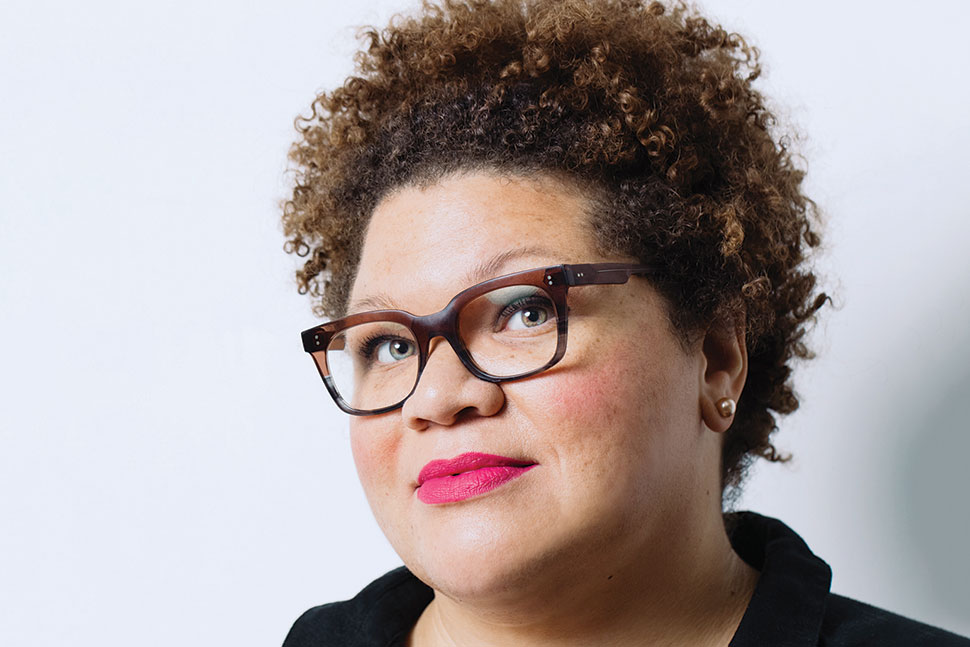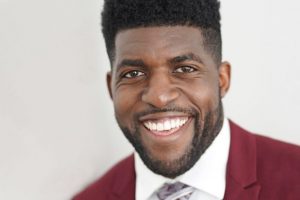
As a woman who is mixed race, has experienced elite schools and generational poverty, and has been thin and fat at different times in her life, Savala Nolan has long felt that she occupies in-between spaces in society. The lawyer, speaker, and writer (whose work has appeared in Bust, Time, and Vogue) explores this liminal territory in her debut collection, Don’t Let It Get You Down: Essays on Race, Gender, and the Body (Simon & Schuster, July), touching topics such as dating, motherhood, and police brutality. American Libraries spoke with Nolan, executive director of the Thelton E. Henderson School of Social Justice at Berkeley (Calif.) Law, about identity, representation, and how libraries can help each of us find our story.
Growing up, did you encounter stories of other people who, like you, hold overlapping identities or experience a sense of dislocation?
When I was a kid, people weren’t thinking about identity the way we do now. I was Black and white and Mexican in an era when we were expected to choose one lane and not hover in any kind of a middle racial space. I was fat and thin. I was put on diets pretty frequently as a kid, but then as diets do, they would implode and I’d be fat again. I went to wealthy private schools for my whole childhood, but I’m not from wealth. My dad was so poor that his home didn’t have running water, so we went to the bathroom in buckets. I just felt like a ping-pong ball, and I did not feel like anyone was with me on that journey. I don’t think I heard stories like that.
The exception that proves the rule: I was maybe 10 years old, and my brother had an opportunity through his work as a musician to get me an autographed headshot of Mariah Carey. She’s Black, white, and Venezuelan, and in that way, she was like me. I remember being just over-the-moon ecstatic that she existed. This photograph she had signed, held in her hand, it was like I had a physical connection to her. It was like sunlight and water to a plant that really needed that nourishment. When I think back on how attached I became to Mariah Carey because of her mixedness, one of the things that tells me is that I was really starving for some validation around all the ways that I was in-between.
Your essay “Dear White Sister” addresses the ways white feminism gaslights and appropriates from women of color, and the emotional labor Black women are often saddled with. What do you hope readers take away from this entry?
This essay focuses on my response to a white friend misusing—or using without appropriate sensitivity and awareness—a very powerful Black-centric song [Beyoncé’s “Freedom”] out of context. But I think if you zoom the camera back more, you can also say this essay is really about the premise of whiteness. Whiteness, at least in this country, is premised on a sense of having a right to every space and every thing. It’s premised on not having to know the impact of what you do. When I say whiteness, I am not talking about white people. But being white means embodying this thing that we call whiteness, [which is] basically a set of habits and assumptions. Among those habits and assumptions is the idea that you have the right to pick up and use anything. You don’t have to turn over any rock you don’t want to turn over, you know? You have a lot of power, and you’re not asked to have commensurate responsibility.
The essay is about a very specific moment—it’s about a specific Instagram post and a specific song—but really what I’m encouraging white readers to question are the habits of whiteness that can be so problematic, the habits of expecting centrality and feeling entitled to any space. And I hope for people who are Black, [the essay] provides voice and language to an incredibly common shared experience in a way that is healing and validating. It’s useful to have language to describe something you’ve experienced, should you experience it again. And there are people who aren’t Black or white, and I hope they see themselves in this piece too.
Were any themes or recollections in the book that were particularly hard to write about?
It was very hard to write about the history of my white family, which goes back through my mom’s side to Virginia, and before that to Wales. They were slaveholders for many decades, from the late 1700s until the Civil War. I wanted to understand how many people we trafficked, where the land was in Virginia that we owned, I wanted to get as complete a picture as I could of that part of my family’s history. That was difficult to face just as a human being.
Many white Americans don’t want to know whether and how involved their families were in human trafficking and chattel slavery, which is sad and a missed opportunity, but I understand a reluctance to know and to reckon with it. It was also, unsurprisingly, very hard as a Black person to sink into the archival material and see on the property taxes the list of children and men and women and teenagers from year to year that my family quote unquote “owned”—legally they did own them, but morally you can’t own someone, so I always feel strange saying [that word]. It was incredibly painful—it made me feel exposed, vulnerable, disgusted, exhausted.
In the acknowledgments of your book, you thank the staffers of the Library of Virginia and UC Berkeley Library, who helped you learn more about your ancestors. What role do libraries play in helping people answer questions about identity?
Oh my gosh, I am more thankful than I can ever say to libraries and librarians and archivists and everyone who keeps them running—there’s a whole ecosystem of people. I feel incredibly indebted to them, and the role they played for me in exploring identity was massive. When you’re looking at family history, there’s the lore and stories passed down, but if you want to authenticate that or go deeper than what Grandma remembers or get into a nitty-gritty topic, you need someone to help you locate the relevant material, ask the right questions, and physically get your hands on the material.
The space of the library is an unsung hero. It’s rare that we have physical spaces that anyone can access and that are calm and rich with resources. There’s something hallowed and sacred about the space, and it created an energy and an atmosphere that let me concentrate on the material in a way that sitting on my couch with my dog and my kid and my laptop and the TV on would not have facilitated. If you have a question about who you are, there’s either a book that will help you figure it out or you should write the book that will help you figure it out. Libraries come into play in either case.
Do you have any favorite libraries?
New York Public Library—I mean, there’s so much majesty in the [main] building, and I just feel so surrounded by knowledge in that place. I studied there in college sometimes. That would rank pretty high, but the one that would rank even higher is Corte Madera Library [in California] that I went to as a kid. I loved the reading room, in part because they had this very big stuffed dragon, all these little nooks and crannies that you could snuggle up in for storytime, and murals on the walls like a magical kingdom. I remember feeling both totally safe in that space and totally transported, and that’s kind of a lovely combination. You feel really grounded but also that you are soaring through the world.


